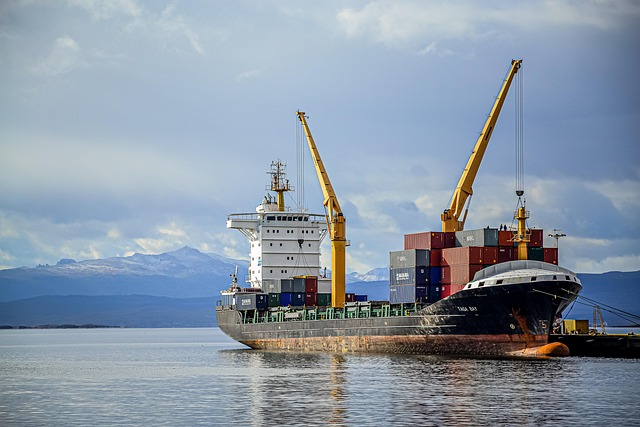Lightweight shipping containers revolutionize freight by offering cost savings through reduced weight, fuel, and labor expenses. They enhance versatility with intermodal transport, customizable dimensions, and leasing services. These containers optimize supply chain efficiency, minimize environmental impact, and enable rapid deployment for diverse cargo needs. The future focuses on modular designs, sustainable materials, growing intermodalization, and smart technologies for real-time tracking and optimized logistics.
Lightweight shipping containers are transforming global trade, offering significant advantages over traditional, heavier alternatives. This innovative approach to freight transportation promises substantial cost savings for businesses while improving overall efficiency. In this comprehensive guide, we explore the rise of lightweight containers, dissecting their economic benefits through detailed analysis. Additionally, we delve into efficient management strategies, environmental considerations, and future trends shaping the containerization landscape.
- The Rise of Lightweight Shipping Containers
- Cost Savings: A Detailed Analysis
- Efficient Freight Management Strategies
- Environmental Impact and Sustainability
- Future Trends in Containerization
The Rise of Lightweight Shipping Containers

The rise of lightweight shipping containers has been a game-changer in the freight industry, revolutionizing container shipping and significantly reducing overall freight costs. Traditional heavy steel shipping containers, while robust and reliable, have long been a significant expense for shippers, contributing to elevated transport costs. However, the introduction of lightweight alternatives, such as modular containers and specialized designs like refrigerated containers or flat rack containers, has disrupted this status quo.
These innovative solutions offer not only weight savings but also enhanced versatility. For instance, intermodal containers can be easily transported via different modes, from sea to road to rail, streamlining the logistics process. Moreover, with dimensions varying from standard ISO containers to specialized shapes like high cube or open top, shippers have more options tailored to specific cargo needs. The availability of container leasing and rental services further adds flexibility, allowing businesses to optimize their operations without a large upfront investment in storage containers.
Cost Savings: A Detailed Analysis

The adoption of lightweight shipping containers offers significant cost savings in the freight industry. By reducing the weight of cargo, transportation and handling expenses are substantially lowered, as less fuel is required to move the containers, and labor costs for loading and unloading are minimized. This is particularly advantageous in container transport, where lighter vessels can carry more cargo, leading to increased efficiency and reduced shipping rates.
Moreover, lightweight containers offer economic benefits throughout the supply chain. They reduce wear and tear on transportation infrastructure, such as roads and rail tracks, lowering maintenance costs. In terms of storage container solutions, these lightweight models provide flexibility, enabling easier stacking and optimized depot utilization. This modularity also allows for rapid deployment and reconfiguration during container leasing or rental services, catering to diverse industry needs.
Efficient Freight Management Strategies

Efficient freight management is a cornerstone of modern logistics, and lightweight shipping containers play a pivotal role in this strategy. By utilizing these innovative solutions, businesses can significantly optimize their supply chain processes. Shipping containers, such as ISO containers or refrigerated containers, offer a modular approach to cargo transport, allowing for easy stacking and efficient loading/unloading processes at ports, warehouses, and distribution centers.
This streamlined approach reduces the time spent on handling and transfer between different modes of transport, like sea container shipping to intermodal container transport on land. Furthermore, with container leasing and rental services readily available, companies can flexibly adapt their freight capacity according to demand, minimizing excess storage or idle transportation costs. Container dimensions and capacities vary to cater to diverse cargo needs, ensuring optimal utilization and cost-effectiveness in every step of the freight journey.
Environmental Impact and Sustainability

The widespread adoption of lightweight shipping containers has brought about a significant reduction in freight costs, but it also offers substantial environmental benefits. Traditional cargo containers, often referred to as intermodal containers or sea containers, are known for their high carbon footprint due to manufacturing processes and the energy required during transport. In contrast, lightweight containers focus on sustainability by utilizing innovative materials and design strategies. These containers typically have lower weight capacities compared to standard ISO containers, but they offer efficient cargo storage solutions without sacrificing environmental friendliness.
By reducing overall container weight, these lightweight variants decrease fuel consumption during shipping, thereby minimizing carbon emissions. Moreover, their modular nature allows for easy disassembly and recycling, contributing to a circular economy. With various types available, such as refrigerated containers, flat rack containers, or high cube containers, the transportation industry can cater to diverse cargo needs while adhering to sustainable practices. This shift towards eco-friendly container shipping is a testament to the industry’s commitment to mitigating environmental impact without compromising on cost-effectiveness.
Future Trends in Containerization

The future of containerization looks set to be shaped by technological advancements and a growing focus on sustainability. As the demand for efficient and cost-effective shipping continues to rise, we’ll likely see further innovation in the design and use of shipping containers. For instance, there’s a growing trend towards modular and customizable containers that can be adapted for various purposes, from storage and transport to temporary offices and refrigerated units. This versatility is particularly appealing for e-commerce businesses and startups requiring flexible logistics solutions.
Intermodal containerization will also continue to gain traction, with more efficient container handling and switching between different modes of transport. The development of smaller, lighter, and more fuel-efficient shipping containers can reduce overall freight costs and lower carbon emissions. Additionally, the integration of smart technologies like IoT sensors could provide real-time tracking and monitoring capabilities, enhancing supply chain visibility and further optimizing container transport and storage at container depots.
Lightweight shipping containers are revolutionizing the freight industry by significantly reducing overall transportation costs. As detailed in this article, their adoption offers substantial economic benefits, coupled with improved efficiency and environmental sustainability. By leveraging these containers, businesses can streamline logistics, enhance competitiveness, and contribute to a greener future. The evolving landscape of containerization promises continued innovation, making lightweight containers an indispensable asset for the modern supply chain.
